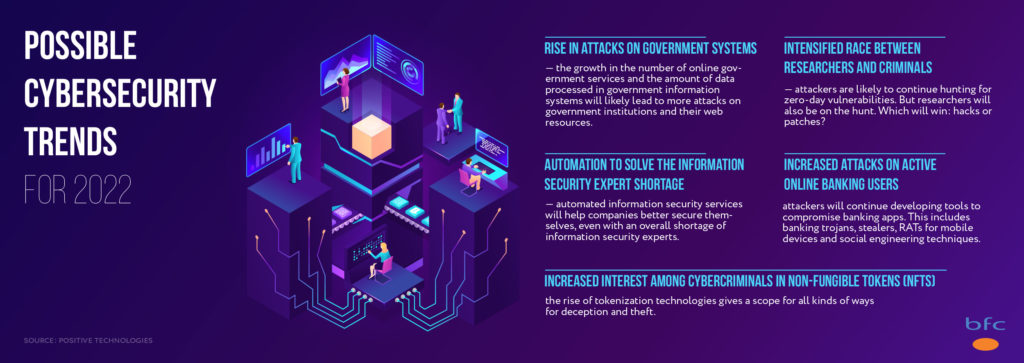Experts from Positive Technologies have identified the main cybersecurity trends from 2021 as well as forecast the most relevant cyber security threats for 2022. Take a look inside this revealing infographic.
Main Cybersecurity Trends from 2021:
- Rising number of ransomware attacks – ransomware attacks in 2021 easily outpaced those that took place in 2020. Alarmingly, the attacks themselves were also much improved in 2021.
- Vulnerabilities in enterprise services – vulnerabilities in in RDP systems and gaps in audio and video communication systems gave attackers good targets in 2021. Surprisingly, many of the vulnerabilities identified were found in software designed to provide protection against hackers.
- Industrial enterprise attacks – phishing emails and hacking attacks were the main methods of attack on industrial enterprises in 2021, with the share of hacking attacks increasing over 2020. This indicates the low level of security of industrial organizations, their large number of vulnerabilities and security flaws that exist in both network perimeters and in internal infrastructures.
- Surge in online fraud within the banking sector – attackers have begun to pay less attention to payment cards and ATMs and switched to online fraud (especially credit fraud by taking advantage of online checks that use onboarding/KYC/AML technologies). In particular, attackers received loans in other names. The rise of this trend is likely due to financial support provided to businesses and individuals during the pandemic.
- A boom in the use (and abuse) of AI technologies – deepfake technologies (in particular, their ability to be run on nearly any device) have allowed attackers to falsify biometric data.
Possible Cybersecurity Trends for 2022:
- Rise in attacks on government systems – the growth in the number of online government services and the amount of data processed in government information systems will likely lead to more attacks on government institutions and their web resources.
- Intensified race between researchers and criminals – attackers are likely to continue hunting for zero-day vulnerabilities. But researchers will also be on the hunt. Which will win: hacks or patches?
- Automation to solve the information security expert shortage – automated information security services will help companies better secure themselves, even with an overall shortage of information security experts.
- Increased attacks on active online banking users – attackers will continue developing tools to compromise banking apps. This includes banking trojans, stealers, RATs for mobile devices and social engineering techniques.
- Increased interest among cybercriminals in non-fungible tokens (NFTs) – the rise of tokenization technologies gives a scope for all kinds of ways for deception and theft.
 BFC Bulletins Monthly News Digest
BFC Bulletins Monthly News Digest




